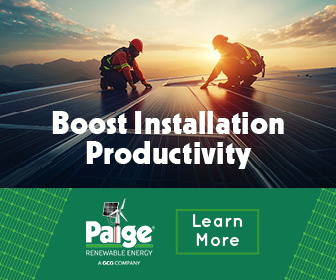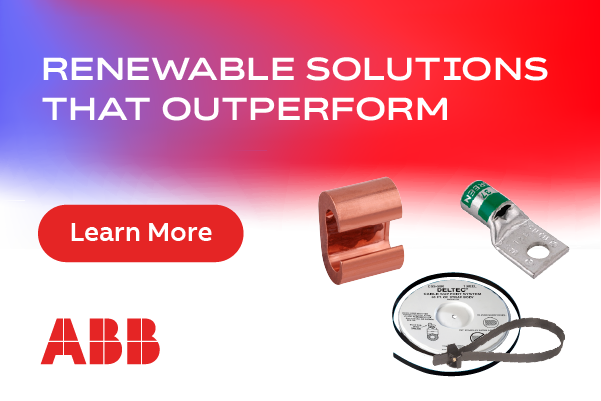Trenchless Solar Cable Management: Above ground cabling alternative delivers above average results
The ultimate goal of every solar plant is to harvest as much clean energy as possible while consuming the fewest resources. Profitability depends on squeezing the most wattage out of every dollar spent on materials, labor, and repairs.
Advances in photovoltaic cell efficiency, combined with falling costs and a push from the federal government, has made solar power more popular than ever. So popular, in fact, that we are running out of space; many of the prime locations for high mega-watt solar farms are either already developed, too expensive, or not in proximity to major population centers.
The result is that more utility-grade solar plants are being constructed on less-desirable lands or locations previously used for other purposes, such as agricultural farms, commercial nurseries, even capped Superfund sites and decommissioned fossil fuel plants. Often contaminated with pollutants, these properties are no longer suitable for commercial development. But they can be repurposed as clean energy producing assets. The question is: How?
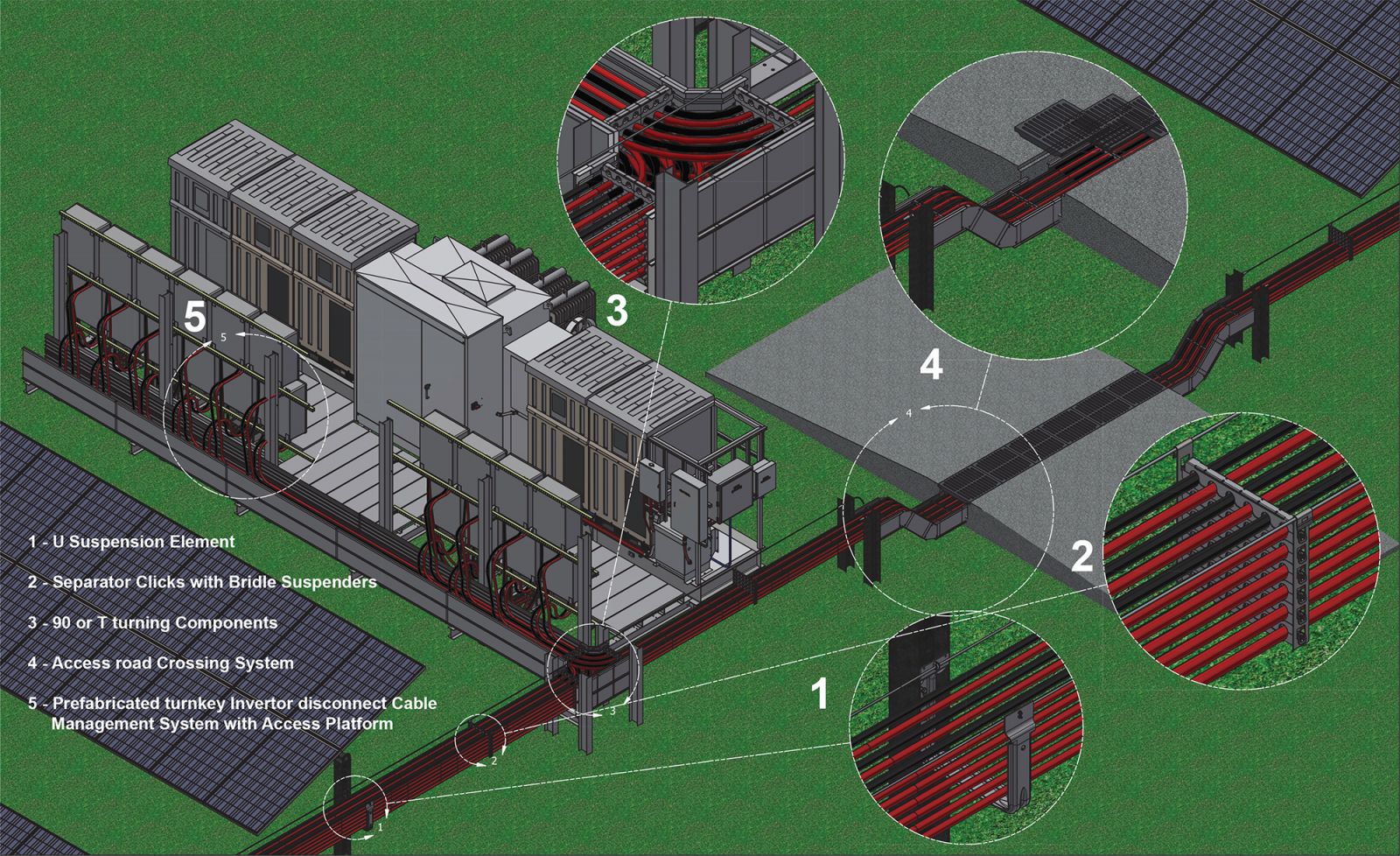
Let’s put aside the environmental issues for a moment to consider the enormity of the task. Even on pristine land, developers will encounter obstacles when trenching - they must account for the effects of derate on buried or bundled cables. Derate is defined as the percentage of electrical capacity that must be reduced to offset the friction heat buildup generated by bundling or burying cables. Article 301 of the National Electrical Code states the derate factor can be as high as 50 percent when running 10 or more buried cables in parallel. That means laying 500 Kc mil cables to realize 250 Kc mil ampacity throughput. Think about the cost of all that wasted copper!
Solar Plant Cabling Options
Utility-grade solar plants are large-scale engineering marvels, occupying hundreds to thousands of acres, with hundreds of rows of solar panels tightly packed into avenues for maximum energy capture. Beneath these arrays are equally intricate pathways of high ampacity cables transporting direct current to inverters at the end of each row, as well as low voltage data and AC lines for sensors monitoring weather conditions, panel performance, and to power the motors allowing the panels to follow the path of the sun.
Solar plant developers have several options when cabling the arrays.
 Bury cable. The traditional method of laying cable directly in the ground is labor intensive, dangerous, sloppy, and expensive. There may be delays caused by weather and geological obstacles. Derate is considerable as earth traps heat, and cable repair is hindered by lack of visibility to an exact failure point.
Bury cable. The traditional method of laying cable directly in the ground is labor intensive, dangerous, sloppy, and expensive. There may be delays caused by weather and geological obstacles. Derate is considerable as earth traps heat, and cable repair is hindered by lack of visibility to an exact failure point.- Run cable inside a pipe. The cable is still trenched and buried, but protected from moisture and the weight of earth. Derate is actually increased due to heat entrapment by the pipes, but repairs are easier as cables can be pulled and replaced without digging.
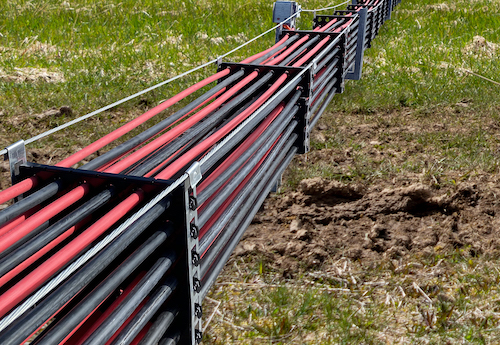 Bundle cables above ground. Now we're getting somewhere; running cables above ground is faster, less expensive to install, avoids trenching/terrain issues, and provides a high level of accessibility for repairs. Above ground bundling will experience some derate due to the cables touching, but less than when inside a pipe. Best for low ampacity DC and low voltage AC cables.
Bundle cables above ground. Now we're getting somewhere; running cables above ground is faster, less expensive to install, avoids trenching/terrain issues, and provides a high level of accessibility for repairs. Above ground bundling will experience some derate due to the cables touching, but less than when inside a pipe. Best for low ampacity DC and low voltage AC cables.- Above ground (Free Air) installation. The nirvana of power transmission physics, Free Air involves no bundling; cables are run above ground with separators that allow heat to dissipate into the air. The derate factor is greatly reduced or eliminated, which lowers cable impedance 25–40 percent over an entire project for a better ROI. Along with its relatively low material cost and minimal labor requirements compared to trenching, Free Air becomes a very economical solution for high ampacity DC cables.
A Case for Free Air Installation
Now let’s return to the environmental and less-than-desirable-location issues, and see how Free Air installation can solve these problems and alleviate trenching and derate factors.
A massive, 630-megawatt solar plant was recently constructed on what was an agricultural farm in the southwest. You’d think there would be a lot of advantages to building a solar plant on farmland: the land is flat, the soil already tilled and free of boulders, roots, and other obstacles.
However, the developer feared trenching would expose workers to high concentrations of fertilizers and pesticides accumulated in the soil from decades of growing crops. There were concerns that rain-induced runoff containing hazardous compounds (brought to the surface by digging) could enter the local water supply. Project engineers decided it was best to leave the ground as undisturbed as possible. The solution: Free Air installation.
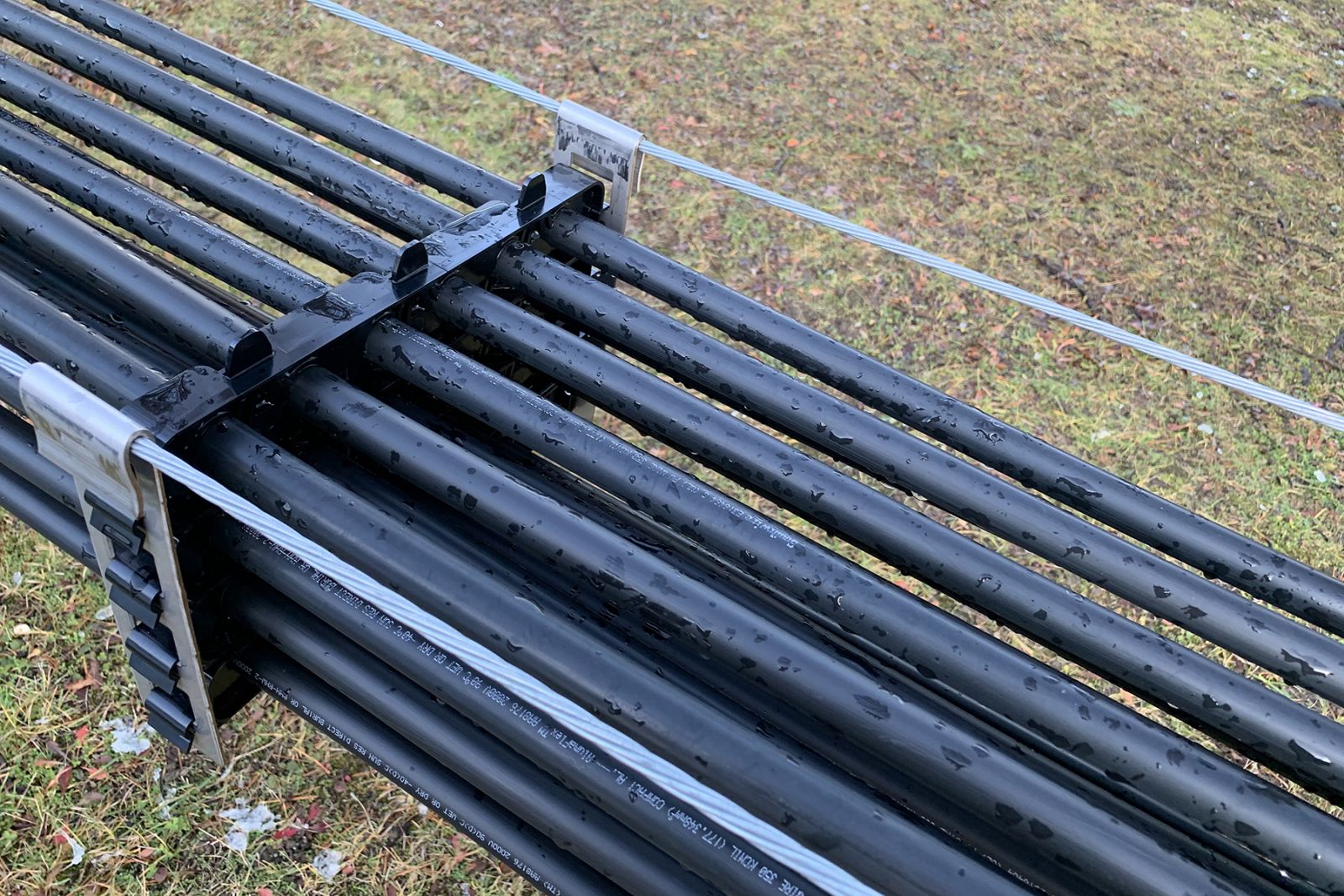 Above ground cable conveyance employs tensioned messenger wire to transport multiple layers of DC cables from the solar panels to an end point under each row. The wires attach to the same I-beam footings driven into the ground to support the solar panels. Brackets are attached with cable spacing trays seated at measured intervals. Complying with NEC Article 301, the trays maintain a uniform 360° space between each cable that allows heat to dissipate into the air, thus maintaining full ampacity and eliminating the need to derate cables.
Above ground cable conveyance employs tensioned messenger wire to transport multiple layers of DC cables from the solar panels to an end point under each row. The wires attach to the same I-beam footings driven into the ground to support the solar panels. Brackets are attached with cable spacing trays seated at measured intervals. Complying with NEC Article 301, the trays maintain a uniform 360° space between each cable that allows heat to dissipate into the air, thus maintaining full ampacity and eliminating the need to derate cables.
Using this method, cabling was finished ahead of schedule and under budget, with installers running about 1,000 feet of cable per day to achieve significant labor savings. Material cost savings were realized through lower ampacity cables that will be used to full capacity, and environmental concerns were eased as the ground was not trenched. Most importantly, the solar plant will realize a faster ROI by harvesting 100 percent of the power it generates.
Quantitative Performance Savings
Not only does Free Air cable conveyance save money on materials and labor, but it increases daily energy harvest by up to 8 percent over traditional methods. Here are the numbers to prove it:
Post-construction, above ground cable conveyance systems have been shown to harvest thousands more watts of clean energy every day that otherwise would be lost to the effects of derate. Using the laws of physics and precise coefficient values for the resistivity of copper at different temperatures, it’s possible to determine the amount of power lost to Ohmic heating. Algorithms convert anticipated power loss percentages into a dollars-and-cents estimate of incremental revenues that could be realized with Free Air installation.
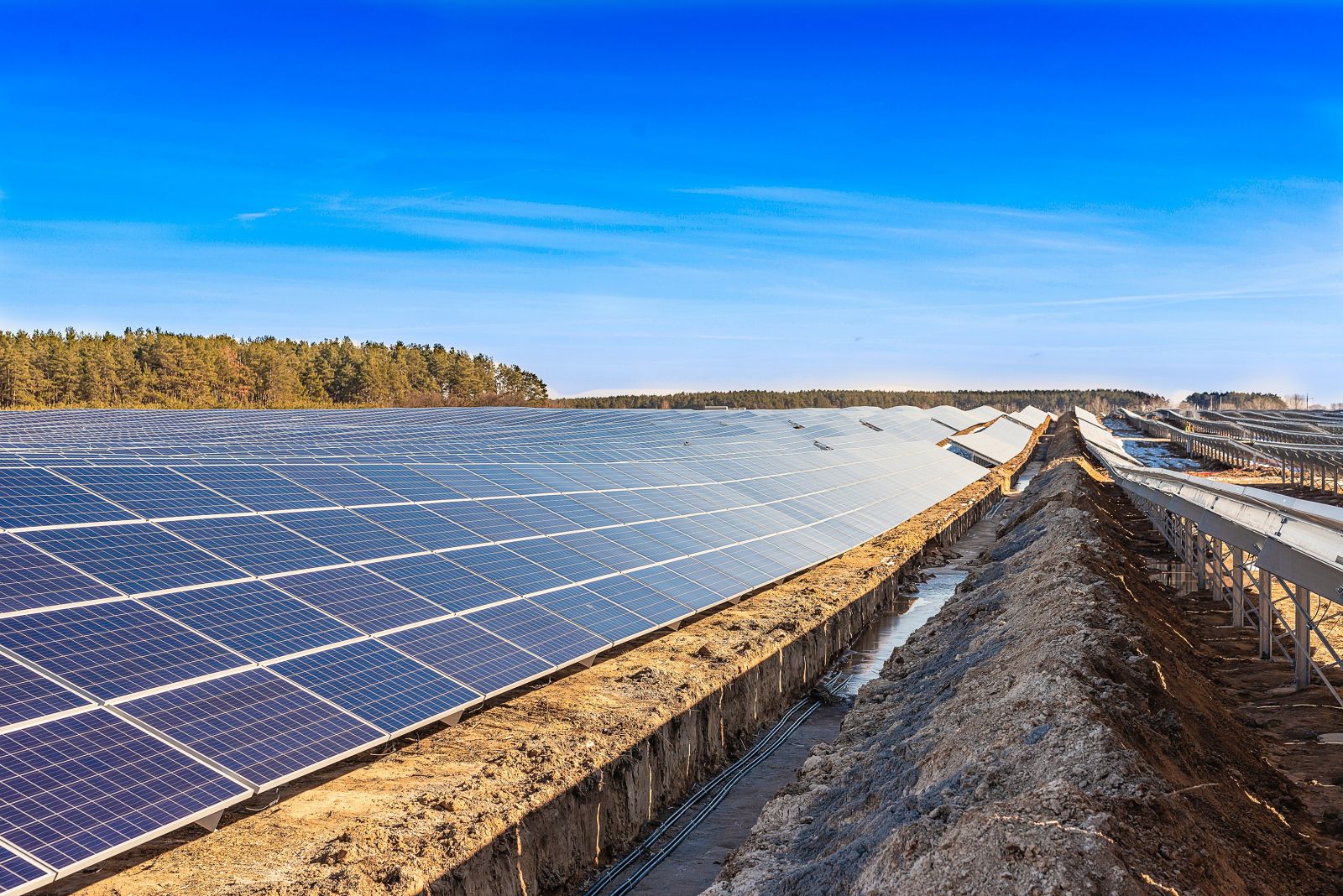
This example illustrates the savings of a bundle of 36 cables, each 1,000 feet long and rated for 700 Amps, at an average ambient temperature of 77°F. When buried, the cables yield 8,072 watts per hour. Using above ground cable conveyance, the same solar array generates 8,779 watts per hour, harvesting an additional 707 watts per hour by not suffering from derate. Using an average Kilowatt price per hour of $0.15, each bundle of 36 cables can generate an additional $3.82/hour, or $45.84/day per run (assuming a 12-hour day). If the average utility-grade solar plant has 125 runs, that equates to $5,730 of daily incremental revenue, or over $2 million dollars per year—every year!
Designed to install quickly, reduce labor and material costs, and harvest more energy daily from the same assets, Free Air systems revolutionize solar plant cable conveyance and deliver above average results.
Michael Markowitz is a technical writer for Brainstorm Studio, a Long Island based digital agency with deep experience in presenting the advantages of cutting-edge technologies. Snake Tray is a US designer and manufacturer of cable management, power distribution and enclosures based in Bay Shore, New York. The company holds over 35 patents for products based on labor-saving innovations.
SnakeTray | www.snaketray.com
Author: Michael Markowitz
Volume: 2022 May/June









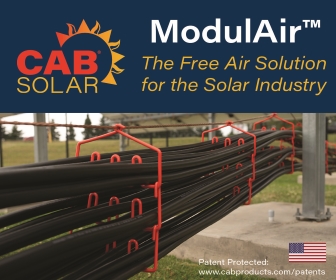
.png?r=1823)
